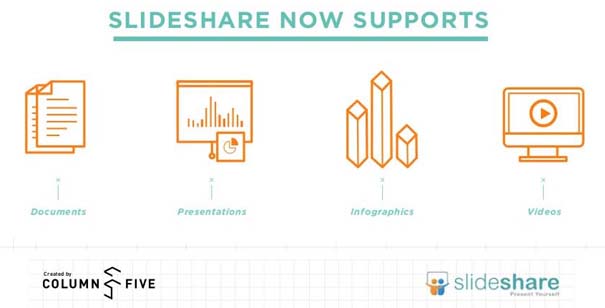
I mean, I could have: saved time, effort, brain cells, earned more money, reached more people, etc. BUT … not today. Today, I’m going to write an article that I’m sure will be super useful for you guys, because it has everything you need to know about repurposing content and getting the most out of every piece of content you create.
Surely, this article on repurposing content will be repurposed at some point.

So, for me, repurposing content, beyond the business benefits, means: saving time, getting to go for a jog, read a chapter of my book, or perhaps send more mails. It means being able to think about developing a product, love life more, spend less brain cells, feel less frustrated or burnt out, etc. etc., etc., etc., etc.. 🙂
When you run out of creativity and time repurposing is the best, basically because you avoid looking like this in front of your computer:

(I’ve actually already used this gif in the article How to create a content calendar = How to be a happier blogger. However, I’m using it again because I feel totally identified by it... That’s basically me before starting to write every article :))
Without further adieu, LET’S GET STARTED!
A- Super Logical Reasons That Will Convince You to Start Repurposing Content
Now that we’ve realized the greatest benefits repurposing content can have on our mental and emotional health, I’m going to share with you a list of reasons, which is a summarized selection of what all the experts say on the topic:
- Promotes SEO: each piece is an asset for SEO
- It’s another opportunity to generate ROI by investing very little time
- It let’s us reach new audience members from different medias
- Reinforces the brand message
- Strengthens the influence and increases authority of the brand or personal brand.
- Allows you to connect a hot topic to content that’s outdated and bring it back into action
- Low-cost creation of “new” content
- Accelerates the process of content production
- Renews and extends the life of content: that is, every time we repurpose, we add “life” to the old content, and we can even repurpose items that’ve already been repurposed 🙂
Throughout the article, I’ll be developing options and ideas to help you start repurposing content, that way you can understand and see each of these reasons “in action”.
B- The Step-by-Step Recipe for Cooking Up an Excellent Mix of Repurposed Content
Even though repurposing content is muuuuuch simpler, faster, and cheaper than writing an article from scratch, that doesn’t mean it doesn’t require some sort of planning.
In order to develop these steps, I’ve used our own experiences as a source of inspiration and also a fantastic infographic that Louis Foong shared in one of his articles.
Step 1
We need to start from the premise that we must have SOMETHING to repurpose. Therefore, whenever we create content, we should create it while thinking about the future too. What do we mean by that? Avoid creating content that’s tied to dates, hot stories, product launches, etc… Because they don’t serve as “evergreen content”. We should think about creating something that can be a solution or contribution for our community today, next month, and if possible, up to a year from now :).
Another thing to point out is: a lot of experts say the content to be repurposed must be excellent, high quality, and at one time or another it should have resulted in a “super hit”. That’s because we want to be sure that what we repurpose will result in another “hit”. To be honest, ALL your pieces should comply with these standards in order to serve in the future to be repurposed or not. The habit of making remarkable things and exceeding the expectations of the audience is the only thing that can demonstrate professionalism and the expertise that we “claim to have”. It also strengthens your authority and influence of the brand, product, or name, on the community that you belong to.

Now that we’ve got that clear, there’s one thing I wish to make as my contribution: Everything we produce isn’t always a HIT, therefore, from my logic and experience, I think we should also repurpose content that maybe had a “mediocre” performance. There’s another aim of repuposing content, and it’s to not waste those “scraps” or forgotten material that other people would throw out. Luckily, today we have a whole artillery of analytic tools that allow us to analyze each article.
We can modify the keyword to another that we’ve found to work better, we can optimize it for SEO given the secrets to the new Google algorithm, among many other methods.That is, it’s possible to repurpose everything, keeping in mind that the final product should always be MUCH BETTER than before. And if your original content was excellent, then repurpose it to make it REMARKABLE.

Step 2:
After we make sure we’ve got SOMETHING to work with, we must be clear about the purpose that the repurposed material will have. To do this, we’ve got to think about the current objectives of our brand or product. The sum of both of these aspects will allow us to decide on what format or approach will be given to the “new content” in order to fulfill its purpose effectively.
Take notes and analyze its purpose:
- Inform
- Teach
- Inspire
- Entertain
- Persuade
- Generate conversations
- Express an opinion and highlight a specific message
- Share knowledge and resources about the industry or category to which you belong and position your product.
- Arouse controversy
Step 3:
Shape the “new content”. Here, the key is creativity and a good strategy for creating a mix of formats in order to get the most out of the “original” content.
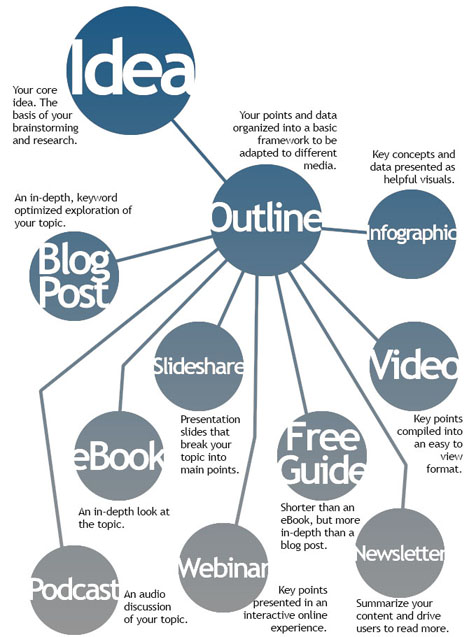
Original Image credit: Vertical Measures
After I complete each of these steps, I’m going to develop this point in particular in more detail with over a dozen ideas that’ll help you repurpose your content creatively. We’ll expand on this in a bit!
Step 4:
Promotion and/or (re)distribution.

In the first place, he argues that the mistake all of us make is in thinking that we have to generate lots and lots and lots and lots of content. This not only leads to a life without life, since we’ve got to work 28×7 in order to make quality content in quantity (I know a day has only 24 hours), but also focusing on only producing won’t attract more readers, subscribers, customers, or whatever it is we need to feel that our business works and is profitable. 🙂
Using his own words, he says:
“Let’s say you have 100 readers. What are the chances that one of those people will love your content so much that they tell ALL of their friends about it? 1%? 2%? If that? Whatever it is, it’s low, and at that rate, you might get 1 new loyal reader. Going from 100 readers to 101 readers isn’t how you build a blog readership.”
In other words, it doesn’t make any sense to keep focusing on creating tons of content that only about 100 people are gonna read, while thousands and thousands are still out there and haven’t even seen something you’ve done yet.
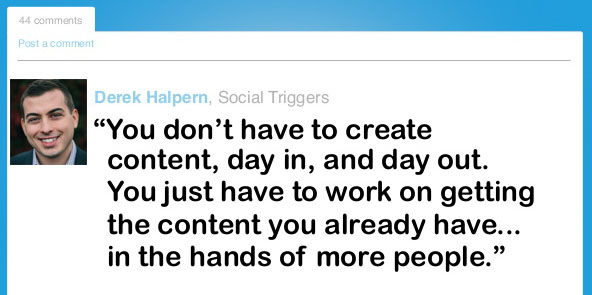
Now are you getting the idea? I hope so!
In addition to expanding your audience, an intelligent promotion and distribution campaign is crucial for positioning your brand, reinforcing influence, and in turn building a solid authority among the leaders of your sector. The infographic I mentioned to you guys before, that Lois Foong shared with us, summarizes the idea and also puts it very simply:

Step 5:
Do this over and over again.

In order to see results, this process must be performed again and again. We’ve got to have patience, love, and perseverance to sustain it over time. You can’t build an audience, or increase your influence and authority with only one attempt.
So … Let’s get to work!
C- The Best Ideas and Strategies to Help You Repurpose Your Content Efficiently
Repurpose an article while maintaining the blog post format.
An essential rule in this case is to be honest and open with your readers. Another saying goes: “He, who warned, does not betray.” Your audience will appreciate it if you tell them the truth. It only takes one reader who feels “cheated” by reading a post similar to something they’ve read before, to destroy your reputation. Thus, explain, clarify, and do whatever it takes for that not to happen.
1- You can modify the article’s approach by targeting something different than what it was originally created for. Example, changing the audience: beginners, professionals, specialists, or the general public. Surely, you can add or remove terms, delve into certain explanations, or make others simpler.
On our Postcron bog in Spanish, we had originally done an article called: “7 Simple Habits That’ll Help You Become a Happier Entrepreneur“. Then we realized we could actually repurpose it and expand on the subject in order to reach a broader audience. We did it and it worked really well! If you want to take advantage of the opportunity and read something to motivate you a little, don’t miss it! Here’s the version in English —> How to Be Happy: 7 Simple Habits Scientifically Proven to Help You Everyday.

3- Series: Maybe you wrote an article that covered several interrelated topics, but none of them were developed in depth. Take one the them and write a shorter article that details a particular point and so on and so on for each topic. Thus, creating a series.
4- Update an article with new information: we did this with one of ours, which was about image dimensions on all social networks, which are constantly changing. Surely, soon, we’ll have to do it again.
5- Connect a current “hot topic” to a previous article, as long as it contributes something relevant. Update it and put it in the race again.
6- Create the “best” or “super” complete guide on XXX subject. This guide can also be a tutorial or can be a ‘How To’.
7- Transform your articles visually: This does not mean make an infographic, but rather while maintaining the blog format, make it more visual by using photo galleries, where you can also include text. For example, Mashable does it fantastically in —> this article
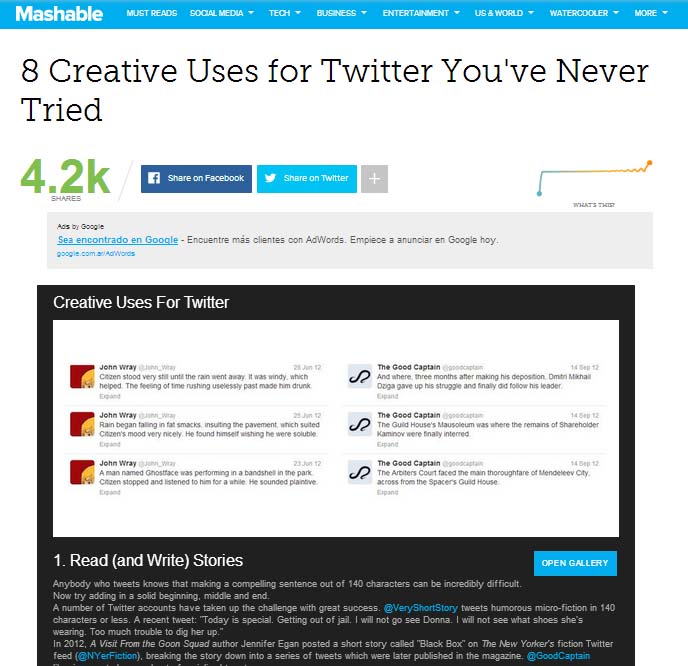
8- Quotes: the simplest and fastest way to repurpose! Take the most important ideas or those that highlight the concept or central message of your article. Then, look for a good image or background color, place your name or brand name on it, and throw in that catchy phrase, and upload it for everyone to share later.

ArtStudio
Usechisel
Pinstamatic
Quotescover
9- Newsletters or email series: Take an article and summarize the most important points. Send it out as a summary to your readers. Another idea might be to send out daily tips or advice. If you’ve written a super practical, interesting article, full of good tips, try sending out one tip at a time with pictures, or if you can find a related video that helps you make your point or give relevance to what you’re trying to say, even better! That’s a super complete newsletter.
10– This particular idea is the opposite of all the above: incorporate a Facebook post on your blog or website. Embedded Posts is a Facebook feature that you can use to bring your Fan Page posts, to your blog or webpage.
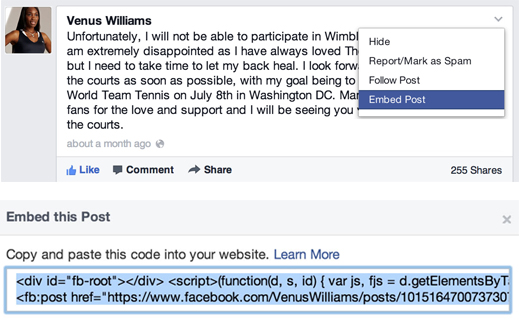
We’ve actually also developed this idea in the article: What every community manager must know: How to Get More Likes on Facebook Part 2
11- Make a “report” in PDF format so it can be downloaded for “free” (or not) by your audience. Share the link on all social networks.
In this case, since your audience will benefit from being able to use excellent material, you can utilize this plugin by WordPress that asks your audience to like, tweet or +1 in exchange for your PDF.

12- Infographics: our article on Social Media Trends 2014: the latest data, infographics and statistics, we highlighted Shutterstock with its 332% growth in searches related to infographics. This resource is fantastic, and the people at Slideshare with Column Five, explain it really well through an infographic, obviously:
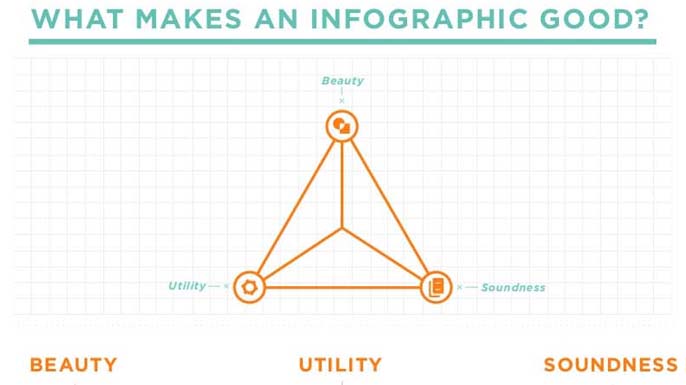
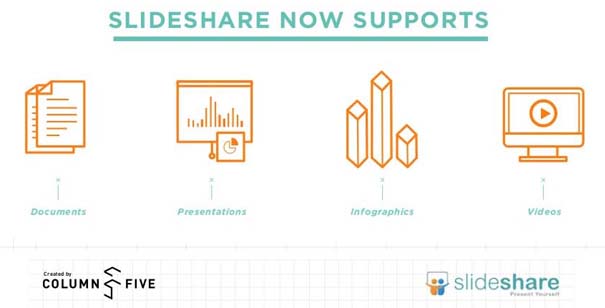
Easel.ly
Infogr.am
Visual.ly
Piktochart
13- Now that we’ve mentioned it, converting your content into presentations on Slideshare is one of the smartest decisions you can make. Not only does it have a community of over 60 million people that you could reach, but it also allows you to analyze and control the following details:

The following ideas require a little bit more commitment, time, and resources but are excellent:
14- E-books: Make a compilation of the articles on your blog that are interrelated to each other, and don’t be afraid to jump into the world of eBooks. You can make a tutorial or super comprehensive guide, or simply offer the best selection of all your work.
15- Podcasts: to put it simply, many bloggers or specialists record their books or blog posts in audio format- That’s a podcast. Later, they upload them to ITunes or different platforms, so that the audience can then download and listen to them later.
Ideal for super busy people who don’t want to miss out on any good piece of information, but don’t have time to sit down and read.
An example is Jeff Bullas. Most of his blog posts are also given in this format, for example —> this one
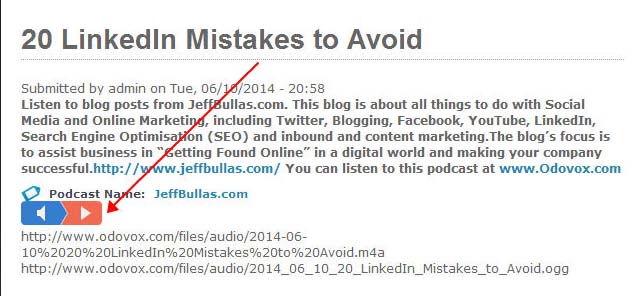
Mari Smith, a specialist in Facebook and social networks, does this all the time. For example:
17- YouTube Videos: If you have a Google Plus account, you can easily create a channel on YouTube. If you have a good background and a good smartphone, you can summarize your article, and a put a face to your words with your presence.
This is a clear example of doing something simple but effective:
Or maybe something more “pro”, as the super sharp and charismatic Derek Halpern does. I chose this video, not only as an example, but because what he shares is really cool. What you’ll take away is super valuable too. Don’t miss it!
To recap all of the above:
ALWAYS create content of excellent quality. Not only will it serve to repurpose in the future, but it’ll help you build your authority and your influence among readers, and even on Google, since each piece of quality content is an asset to the SEO. Nor forget that the key to this whole process, is the distribution and promotion of your content. It’s useless to create material to be appreciated by only 100 readers. Move your influences, knock on doors, and bring your work to spaces related to your niche in order to reach more readers. Obviously, social networks are indispensable. Don’t forget to share on Facebook, Twitter, LinkedIn, Google Plus, and selected forums. Be creative, and remember that one seagull doesn’t make it summer, you’ve got to repeat this as many times as you can.
I hope this article has helped you, I’ve got to get to work on this too!
If you’ve found it useful, and think it might be useful for anoooother person you know, don’t hesitate to share it and comment on it. Your comments help me out a lot!

